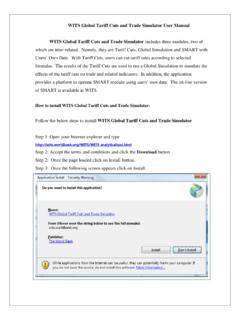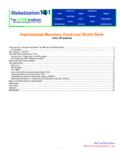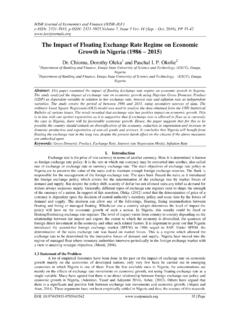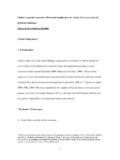Transcription of Irma Rosenberg: Monetary policy and the Swedish economy ...
1 BIS Review 12/2003 1 irma rosenberg : Monetary policy and the Swedish economy Speech by Ms irma rosenberg , Deputy Governor of Sveriges Riksbank, to the Swedish Society of Financial Analysts, Stockholm, 5 March 2003. * * * Thank you for the invitation to come here and speak at the Swedish Society of Financial Analysts. This is my first public appearance in my new role as Deputy Governor of the Riksbank. It is stimulating to meet people and discuss economic issues. At the same time, I feel a little nervous, as I know I am facing an audience who are used to examining and interpreting statements by the Riksbank. One difference between this post and my previous work is that a member of the Executive Board must to some extent exercise caution when speaking publicly. This is to avoid creating any misunderstandings among participants in the financial market, who try to translate statements by representatives of the central bank into future interest rate policy .
2 This means that some of you may not be acquainted with me, but my aim is to be as honest and clear as I possibly can. What I intend to start talking about today is the development of the economy in recent years and to follow this with a look ahead at the challenges facing both the Swedish and international economic climates, and finally say something about Monetary policy . Those of you who are familiar with the economic assessments I have made know that I sometimes have not shared the Riksbank s conclusions. But please remember that this should not be interpreted to mean that I have a different opinion of the Riksbank s objectives. I consider it a good thing to conduct an open discussion on the policy pursued. And I hope that you intend to take part in this discussion, as the whole point of an open central bank is to facilitate such discussion and allow it to improve Monetary policy .
3 Riksbank focuses on total inflation picture I shall begin by describing the way the Riksbank works. The Riksdag has assigned two main objectives to the Riksbank: to maintain price stability and to promote a safe and efficient payment system. Today I shall concentrate on the first of these two objectives. The Riksbank has defined the target for Monetary policy as to limit inflation to 2 per cent, with a tolerated deviation interval of plus/minus one percentage point. This tolerated interval indicates that deviations are likely, but that they will be limited. The objective is worded in terms of the consumer price index (CPI), which is a broad index consisting of the prices in a basket of goods and services consumed by an average Swedish household. As interest costs and indirect taxes included in CPI inflation are not assessed to have a long-term effect on inflation, the Riksbank has chosen to normally focus on UND1X, which is an index that excludes these factors.
4 From time to time there may also be reason to disregard other price changes that are assessed as temporary. Our ambition will then be to make it clear that we have done so. By raising and lowering the steering interest rate - the repo rate - the Riksbank attempts to influence inflation. As it is so difficult to steer inflation in the short term, the Riksbank makes an assessment of developments for the coming 1-2 years. This is the period of time usually assumed necessary for an interest rate adjustment to work its way through the economy and have a full impact on the rate of price increase, inflation. The Riksbank uses a simple rule-of-thumb when shaping its Monetary policy . If the total picture of inflation shows that it is expected to be above or below the target level, the steering interest rate is adjusted accordingly. There are four main factors in the analysis of future inflation that stand out as central to the shaping of Monetary policy : the development of total resource utilisation, international price trends, the exchange rate and the general public s inflation expectations.
5 Inflationary pressure varies according to the demand situation and to changes in resource utilisation. The stronger the upturn in demand in relation to potential production, the greater the risk that prices and wages will rise rapidly and vice versa. This is why we who work in central banks around the world must analyse the picture of economic activity as a whole, despite the fact that inflation is our target variable. International price trends, where, for instance, oil prices are an important factor, affect domestic inflation by way of imports. An assessment of international resource utilisation can provide an indication, for instance, of how international prices may develop. The development in the value of the krona is important in the assessment of inflation. A change in the exchange rate has a direct effect on inflation in that the price of imported goods and services is affected, and also an indirect effect via aggregate demand.
6 If the value of the krona changes in relation to other important trading currencies, this affects the competitiveness of Swedish goods and services and thereby demand and resource utilisation. Inflation expectations among households and companies can also affect the price-setting and wage formation processes and thereby inflation. One purpose of a clear inflation target and a Monetary policy governed by such a target is to firmly establish the inflation target with the general public. At the same time, one should remember that the Riksbank is forced to take into account many other factors that influence price trends. These are often non-recurring factors, such as supply shocks in various forms, which are often difficult to predict. But above all it can be difficult to use Monetary policy to prevent them having an impact on inflation. Monetary policy has an impact with a time lag, and it does not always reach the source of such a price rise.
7 For instance, a central bank cannot prevent oil prices rising in the wake of the concern over a possible war in the Middle East. On the other hand, a central bank could of course try to quickly tighten demand in the country to push down prices in other areas and thus ensure the average rate of price increase remains in line with the target level. The focus on inflation 1-2 years ahead, entails Monetary policy being conducted gradually, little by little, rather than a constant acceleration and braking, which would risk creating unnecessary variations in demand and which could in turn have a negative effect on production and employment. The focus on the coming 1-2 year period thus means that temporary rises or falls in the inflation rate can be tolerated. However, it is important that the Riksbank is clear in its communication of whether it considers the rise to be temporary and when it expects it to subside.
8 One-off shifts in price levels can have a more lasting effect on future inflation if, for instance, those involved do not believe that the rise is temporary, assessing that it will be lasting and thus wishing to compensate for the upturn. If this occurs, Monetary policy must be used to intervene, even if the economic situation in itself does not provide cause for concern with regard to inflation, to prevent inflation taking a hold through expectations. The reason for this is quite simply that it is more costly in terms of reduced production and employment to force down inflation expectations once they have become established at a higher level rather than to prevent them rising. Parallels between the current situation and 2001 plus 2002 Let us take a look at the current situation and begin with the price rises. Now, as in spring 2001, inflation has risen as a result of temporary factors pulling up the general level of prices.
9 During 2001 mad-cow disease and foot-and-mouth disease pushed up meat prices and poor harvests led to soaring prices on fruit and vegetables. Then as now there was also a water shortage in the hydroelectric power companies reservoirs, which pushed up electricity prices. At the moment, it is electricity and oil prices that are soaring and have pushed up inflation figures above the target level in January. This becomes particularly clear if one separates energy prices from the inflation figures for January (Diagram 1). The Riksbank s assessment is that the upturn in inflation is temporary, as it was in 2001, and we can expect to see lower inflation as early as the late spring and summer. However, our assessment is based on the assumption that those setting prices will not try to compensate themselves for the temporary price increase.
10 If this occurs, there is a risk of inducing tendencies towards an inflation spiral, which the Riksbank could not stand by and witness in silence. At the same time, it would be very unfortunate, particularly in the light of the challenges facing the Swedish economy , to be forced to manage contagion effects from the energy price rise with interest rate rises. If one looks at the economic climate, I consider the similarities between the present situation and this time last year to be more striking than a comparison with 2001. Here I am mainly referring to the fact that economic prospects were at that time very uncertain with regard to how far the adaptation process had come after the over-optimism of the previous years, which had led to abnormally high share prices and overly large investments by companies in the USA. Let me go back in time roughly one year and see what conclusions can be drawn from last year and what implications they might have for future developments.

















